Importance of blur with image gradients
While working on generative paintings with brush strokes, aligning the brush strokes with the gradients of the colors in the source images can make a huge difference on the results of the rendering. It's really important to first blur your source image before you calculate the gradients.
In the images below you can see the results of calculating the gradients with and withouth blurring the source/input image.
Brush strokes without blur:

Brush strokes with blur:

I created a simple blur shader which reads from the current
GL_READ_FRAMEBUFFER and then applies a horizontal + vertical blur and
stores the result in a texture that you can read back by
calling setAsReadBuffer(). (I'm using a couple of custom classes
for logging which you can simple remove or create your own macro
to replace them; see RX_*()).
Blur.h
/* # Blur Simple blur shader which performs 2 passes; a vertical and horizontal blur. This class assumes you set the read framebuffer and then call blur(). We read the current GL_READ_FRAMEBUFFER into our intermediate scene texture and then perfrom 2 passes. This means we might have one extra blit which might be considered a performance issue; thouh on modern gpus you won't notice anything. To use the blurred result, call setAsReadBuffer() and either blit it to the default framebuffer or do something else with it */ #ifndef ROXLU_BLUR_H #define ROXLU_BLUR_H #include <roxlu/core/Constants.h> #include <roxlu/opengl/GL.h> static const char* B_VS = "" "#version 150\n" "const float w = 1.0;" "const float h = 1.0;" "const vec2 vertices[4] = vec2[](" " vec2(-w, h), " " vec2(-w, -h), " " vec2( w, h), " " vec2( w, -h) " ");" "const vec2 texcoords[4] = vec2[] (" " vec2(0.0, 0.0), " " vec2(0.0, 1.0), " " vec2(1.0, 0.0), " " vec2(1.0, 1.0) " ");" "out vec2 v_tex;" "void main() {" " gl_Position = vec4(vertices[gl_VertexID], 0.0, 1.0);" " v_tex = texcoords[gl_VertexID]; " "}" ""; class Blur { public: Blur(); ~Blur(); bool setup(int winW, int winH, float blurAmount = 8.0f, int texFetches = 5); void blur(); /* applies the blur */ void setAsReadBuffer(); /* sets the result to the current read buffer */ private: bool setupFBO(); bool setupShader(); float gauss(const float x, const float sigma2); void shutdown(); /* resets this class; destroys all allocated objects */ public: GLuint fbo; /* the framebuffer for rtt */ GLuint depth; /* depth buffer; not 100% we actually need one */ GLuint vao; /* we use attribute-less rendering; but we need a vao as GL core 3 does not allow drawing with the default VAO */ GLuint prog0; /* program for the vertical blur */ GLuint prog1; /* program for the horizontal blur */ GLuint vert; /* the above vertex shader */ GLuint frag0; /* vertical fragment shader */ GLuint frag1; /* horizontal fragment shader */ GLuint tex0; /* first pass (scene capture) + combined blur */ GLuint tex1; /* intermedia texture */ int win_w; /* width of the window/fbo */ int win_h; /* height of the window/fbo */ float blur_amount; /* the blur amount, 5-8 normal, 8+ heave */ int num_fetches; /* how many texel fetches (half), the more the heavier for the gpu but more blur */ }; #endif
Blur.cpp
#include <assert.h> #include <math.h> #include <roxlu/opengl/GL.h> #include <roxlu/opengl/Error.h> #include <roxlu/core/Log.h> #include <sstream> #include <string.h> #include "Blur.h" Blur::Blur() :fbo(0) ,depth(0) ,vao(0) ,prog0(0) ,prog1(0) ,vert(0) ,frag0(0) ,frag1(0) ,tex0(0) ,tex1(0) ,win_w(0) ,win_h(0) ,blur_amount(0) ,num_fetches(0) { } Blur::~Blur() { shutdown(); } bool Blur::setup(int winW, int winH, float blurAmount, int texFetches) { assert(winW); assert(winH); assert(blurAmount); assert(texFetches); win_w = winW; win_h = winH; blur_amount = blurAmount; num_fetches = texFetches; glGenVertexArrays(1, &vao); if(!setupFBO()) { shutdown(); return false; } if(!setupShader()) { shutdown(); return false; } return true; } bool Blur::setupFBO() { glGenFramebuffers(1, &fbo); glBindFramebuffer(GL_FRAMEBUFFER, fbo); glGenRenderbuffers(1, &depth); glBindRenderbuffer(GL_RENDERBUFFER, depth); glRenderbufferStorage(GL_RENDERBUFFER, GL_DEPTH_COMPONENT32, win_w, win_h); glFramebufferRenderbuffer(GL_FRAMEBUFFER, GL_DEPTH_ATTACHMENT, GL_RENDERBUFFER, depth); glGenTextures(1, &tex0); glBindTexture(GL_TEXTURE_2D, tex0); glTexImage2D(GL_TEXTURE_2D, 0, GL_RGBA8, win_w, win_h, 0, GL_RGBA, GL_UNSIGNED_BYTE, NULL); glTexParameteri(GL_TEXTURE_2D, GL_TEXTURE_MIN_FILTER, GL_LINEAR); glTexParameteri(GL_TEXTURE_2D, GL_TEXTURE_MAG_FILTER, GL_LINEAR); glFramebufferTexture2D(GL_FRAMEBUFFER, GL_COLOR_ATTACHMENT0, GL_TEXTURE_2D, tex0, 0); glGenTextures(1, &tex1); glBindTexture(GL_TEXTURE_2D, tex1); glTexImage2D(GL_TEXTURE_2D, 0, GL_RGBA8, win_w, win_h, 0, GL_RGBA, GL_UNSIGNED_BYTE, NULL); glTexParameteri(GL_TEXTURE_2D, GL_TEXTURE_MIN_FILTER, GL_LINEAR); glTexParameteri(GL_TEXTURE_2D, GL_TEXTURE_MAG_FILTER, GL_LINEAR); glFramebufferTexture2D(GL_FRAMEBUFFER, GL_COLOR_ATTACHMENT1, GL_TEXTURE_2D, tex1, 0); GLenum status = glCheckFramebufferStatus(GL_FRAMEBUFFER); if(status != GL_FRAMEBUFFER_COMPLETE) { RX_ERROR("Framebuffer not complete"); shutdown(); return false; } return true; } bool Blur::setupShader() { // CREATE SHADER SOURCES // ----------------------------------------------------------------------- int num_els = num_fetches; /* kernel size */ float* weights = new float[num_els]; float sum = 0.0; float sigma2 = blur_amount; weights[0] = gauss(0,sigma2); sum = weights[0]; for(int i = 1; i < num_els; i++) { weights[i] = gauss(i, sigma2); sum += 2 * weights[i]; } for(int i = 0; i < num_els; ++i) { weights[i] = weights[i] / sum; } float dy = 1.0 / win_h; float dx = 1.0 / win_w; std::stringstream xblur; std::stringstream yblur; std::stringstream base_frag; base_frag << "#version 150\n" << "uniform sampler2D u_scene_tex;\n" << "in vec2 v_tex;\n" << "out vec4 fragcolor;\n"; xblur << base_frag.str() << "void main() {\n" << " fragcolor = texture(u_scene_tex, v_tex) * " << weights[0] << ";\n"; yblur << base_frag.str() << "void main() {\n" << " fragcolor = texture(u_scene_tex, v_tex) * " << weights[0] << ";\n"; for(int i = 1 ; i < num_els; ++i) { yblur << " fragcolor += texture(u_scene_tex, v_tex + vec2(0.0, " << float(i) * dy << ")) * " << weights[i] << ";\n" ; yblur << " fragcolor += texture(u_scene_tex, v_tex - vec2(0.0, " << float(i) * dy << ")) * " << weights[i] << ";\n" ; xblur << " fragcolor += texture(u_scene_tex, v_tex + vec2(" << float(i) * dx << ", 0.0)) * " << weights[i] << ";\n" ; xblur << " fragcolor += texture(u_scene_tex, v_tex - vec2(" << float(i) * dx << ", 0.0)) * " << weights[i] << ";\n" ; } yblur << "}"; xblur << "}"; delete weights; weights = NULL; // ----------------------------------------------------------------------- std::string yblur_s = yblur.str(); std::string xblur_s = xblur.str(); const char* yblur_vss = yblur_s.c_str(); const char* xblur_vss = xblur_s.c_str(); vert = glCreateShader(GL_VERTEX_SHADER); glShaderSource(vert, 1, &B_VS, NULL); glCompileShader(vert); eglGetShaderInfoLog(vert); frag0 = glCreateShader(GL_FRAGMENT_SHADER); glShaderSource(frag0, 1,&yblur_vss, NULL); glCompileShader(frag0); eglGetShaderInfoLog(frag0); prog0 = glCreateProgram(); glAttachShader(prog0, vert); glAttachShader(prog0, frag0); glLinkProgram(prog0); eglGetShaderLinkLog(prog0); frag1 = glCreateShader(GL_FRAGMENT_SHADER); glShaderSource(frag1, 1, &xblur_vss, NULL); glCompileShader(frag1); eglGetShaderInfoLog(frag1); prog1 = glCreateProgram(); glAttachShader(prog1, vert); glAttachShader(prog1, frag1); glLinkProgram(prog1); eglGetShaderLinkLog(prog1); GLint u_scene_tex = 0; // set scene tex unit for 1st pass glUseProgram(prog0); u_scene_tex = glGetUniformLocation(prog0, "u_scene_tex"); if(u_scene_tex < 0) { RX_ERROR("Cannot find u_scene_tex (1)"); shutdown(); return false; } glUniform1i(u_scene_tex, 0); // set scene tex unit for 2nd pass glUseProgram(prog1); u_scene_tex = glGetUniformLocation(prog1, "u_scene_tex"); if(u_scene_tex < 0) { RX_ERROR("Cannot find u_scene_tex (2)"); shutdown(); return false; } glUniform1i(u_scene_tex, 0); return true; } void Blur::blur() { assert(fbo); // Blur the current read framebuffer into our first attachment (the source) GLenum draw_bufs0[] = { GL_COLOR_ATTACHMENT0 } ; glBindFramebuffer(GL_DRAW_FRAMEBUFFER, fbo); glClear(GL_COLOR_BUFFER_BIT | GL_DEPTH_BUFFER_BIT); glDrawBuffers(1, draw_bufs0); glViewport(0,0,win_w, win_h); glBlitFramebuffer(0, 0, win_w, win_h, 0, 0, win_w, win_h, GL_COLOR_BUFFER_BIT, GL_LINEAR); glBindVertexArray(vao); { // vertical blur GLenum draw_bufs1[] = { GL_COLOR_ATTACHMENT1 } ; glDrawBuffers(1, draw_bufs1); glActiveTexture(GL_TEXTURE0); glBindTexture(GL_TEXTURE_2D, tex0); glUseProgram(prog0); glDrawArrays(GL_TRIANGLE_STRIP, 0, 4); } { // horizontal blur GLenum draw_bufs1[] = { GL_COLOR_ATTACHMENT0 } ; glDrawBuffers(1, draw_bufs1); glActiveTexture(GL_TEXTURE0); glBindTexture(GL_TEXTURE_2D, tex1); glUseProgram(prog1); glDrawArrays(GL_TRIANGLE_STRIP, 0, 4); } glBindFramebuffer(GL_DRAW_FRAMEBUFFER, 0); } void Blur::setAsReadBuffer() { assert(fbo); glBindFramebuffer(GL_DRAW_FRAMEBUFFER, 0); glBindFramebuffer(GL_READ_FRAMEBUFFER, fbo); glReadBuffer(GL_COLOR_ATTACHMENT0); } float Blur::gauss(const float x, const float sigma2) { double coeff = 1.0 / (2.0 * PI * sigma2); double expon = -(x*x) / (2.0 * sigma2); return (float) (coeff*exp(expon)); } void Blur::shutdown() { if(fbo) { glDeleteFramebuffers(1, &fbo); } fbo = 0; if(depth) { glDeleteRenderbuffers(1, &depth); } depth = 0; if(vao) { glDeleteVertexArrays(1, &vao); } vao = 0; if(prog0) { glDeleteProgram(prog0); } prog0 = 0; if(prog1) { glDeleteProgram(prog1); } prog1 = 0; if(vert) { glDeleteShader(vert); } vert = 0; if(frag0) { glDeleteShader(frag0); } frag0 = 0; if(frag1) { glDeleteShader(frag1); } frag1 = 0; if(tex0) { glDeleteTextures(1, &tex0); } tex0 = 0; if(tex1) { glDeleteTextures(1, &tex1); } tex1 = 0; win_w = 0; win_h = 0; blur_amount = 0.0f; num_fetches = 0; }
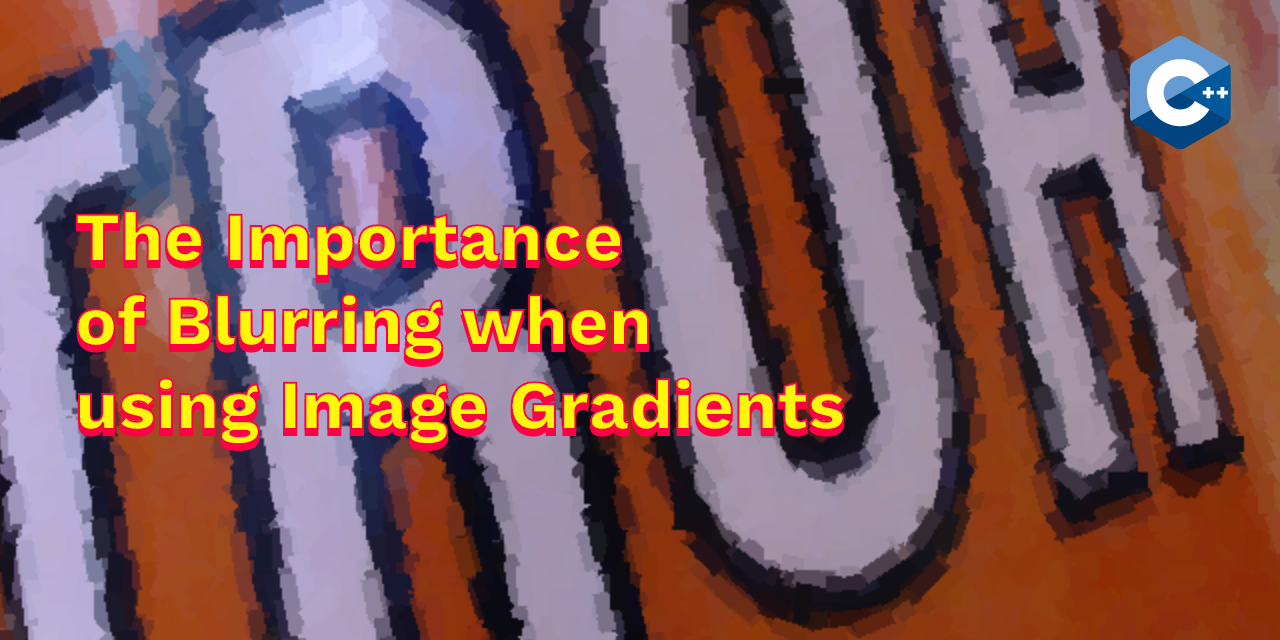
 NAT Types
NAT Types
 Building Cabinets
Building Cabinets
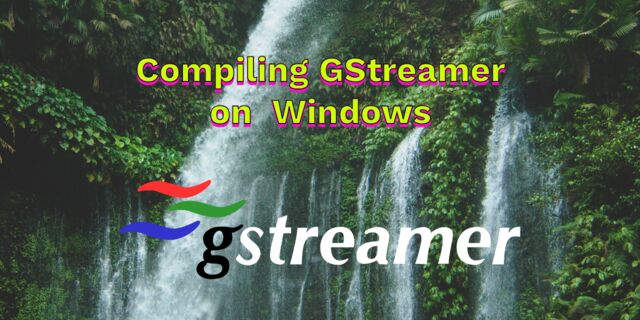 Compiling GStreamer from source on Windows
Compiling GStreamer from source on Windows
 Debugging CMake Issues
Debugging CMake Issues
 Dual Boot Arch Linux and Windows 10
Dual Boot Arch Linux and Windows 10
 Mindset Updated Edition, Carol S. Dweck (Book Notes)
Mindset Updated Edition, Carol S. Dweck (Book Notes)
 How to setup a self-hosted Unifi NVR with Arch Linux
How to setup a self-hosted Unifi NVR with Arch Linux
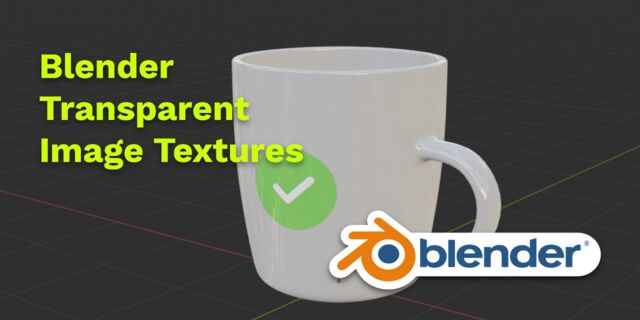 Blender 2.8 How to use Transparent Textures
Blender 2.8 How to use Transparent Textures
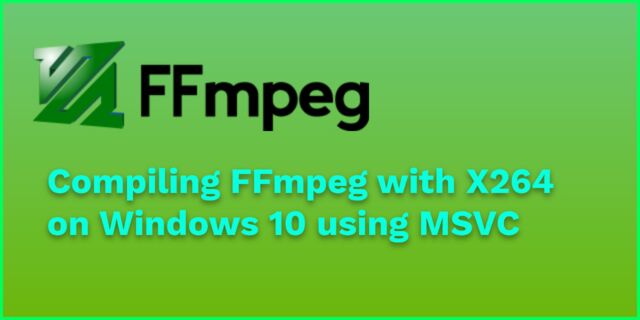 Compiling FFmpeg with X264 on Windows 10 using MSVC
Compiling FFmpeg with X264 on Windows 10 using MSVC
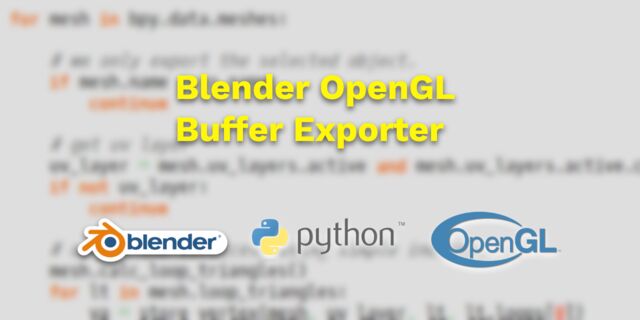 Blender 2.8 OpenGL Buffer Exporter
Blender 2.8 OpenGL Buffer Exporter
 Blender 2.8 Baking lightmaps
Blender 2.8 Baking lightmaps
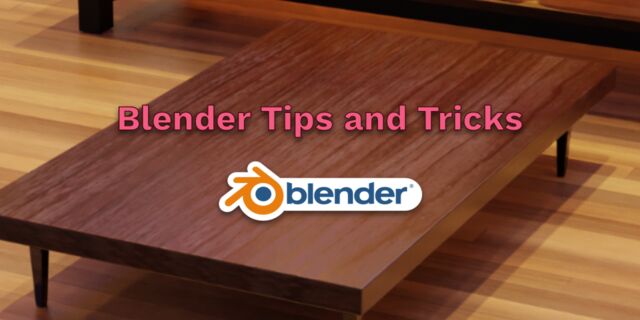 Blender 2.8 Tips and Tricks
Blender 2.8 Tips and Tricks
 Setting up a Bluetooth Headset on Arch Linux
Setting up a Bluetooth Headset on Arch Linux
 Compiling x264 on Windows with MSVC
Compiling x264 on Windows with MSVC
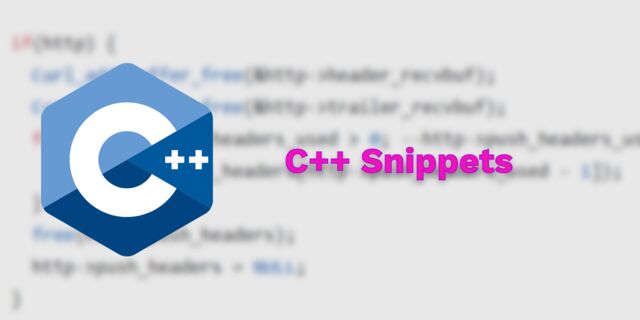 C/C++ Snippets
C/C++ Snippets
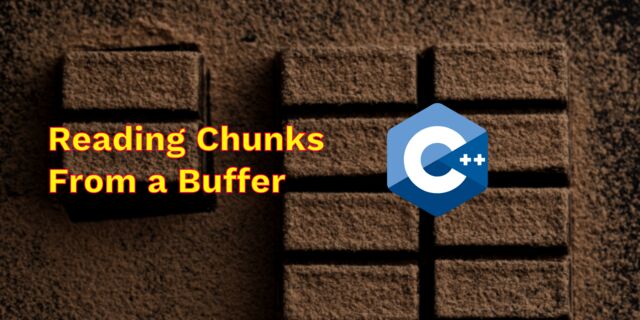 Reading Chunks from a Buffer
Reading Chunks from a Buffer
 Handy Bash Commands
Handy Bash Commands
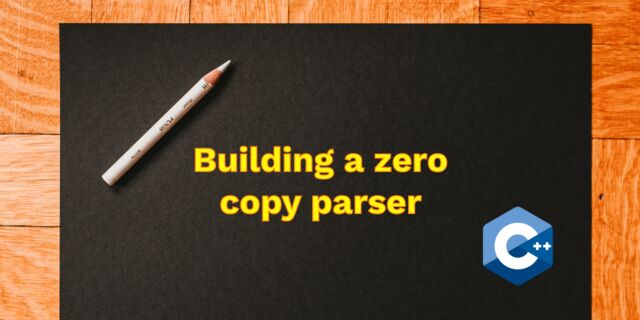 Building a zero copy parser
Building a zero copy parser
 Kalman Filter
Kalman Filter
 Saving pixel data using libpng
Saving pixel data using libpng
 Compile Apache, PHP and MySQL on Mac 10.10
Compile Apache, PHP and MySQL on Mac 10.10
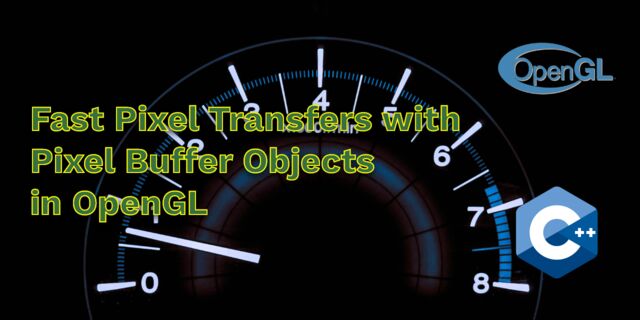 Fast Pixel Transfers with Pixel Buffer Objects
Fast Pixel Transfers with Pixel Buffer Objects
 High Resolution Timer function in C/C++
High Resolution Timer function in C/C++
 Rendering text with Pango, Cairo and Freetype
Rendering text with Pango, Cairo and Freetype
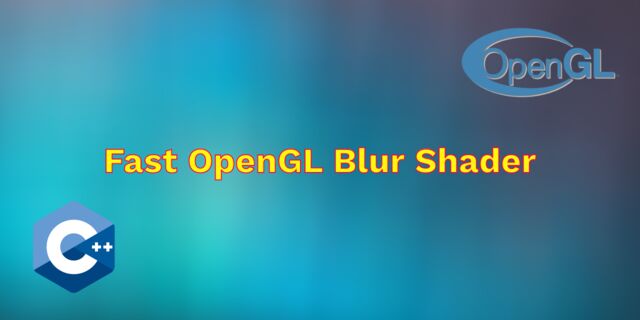 Fast OpenGL blur shader
Fast OpenGL blur shader
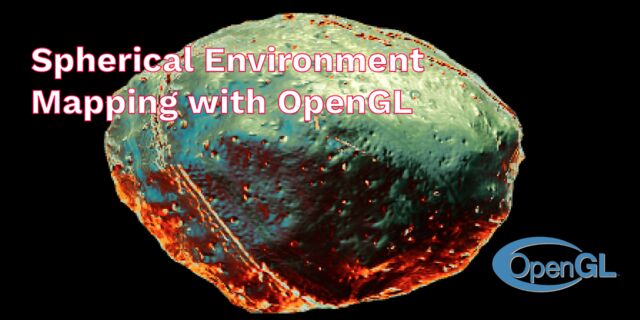 Spherical Environment Mapping with OpenGL
Spherical Environment Mapping with OpenGL
 Using OpenSSL with memory BIOs
Using OpenSSL with memory BIOs
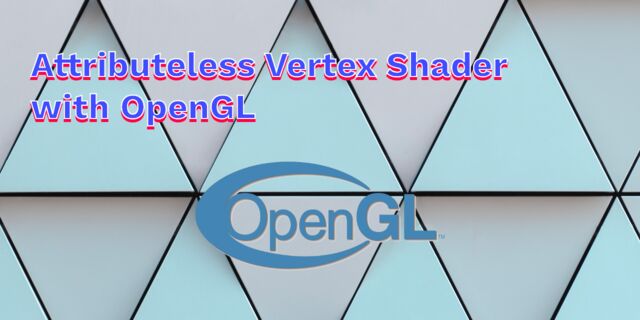 Attributeless Vertex Shader with OpenGL
Attributeless Vertex Shader with OpenGL
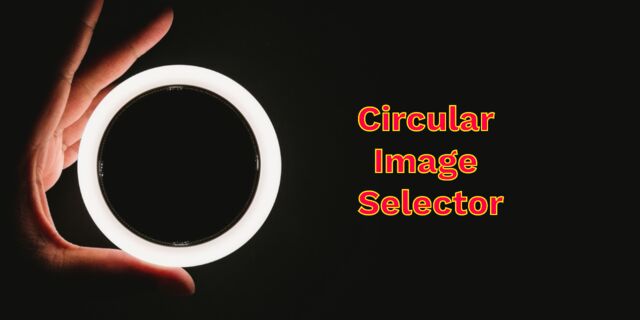 Circular Image Selector
Circular Image Selector
 Decoding H264 and YUV420P playback
Decoding H264 and YUV420P playback
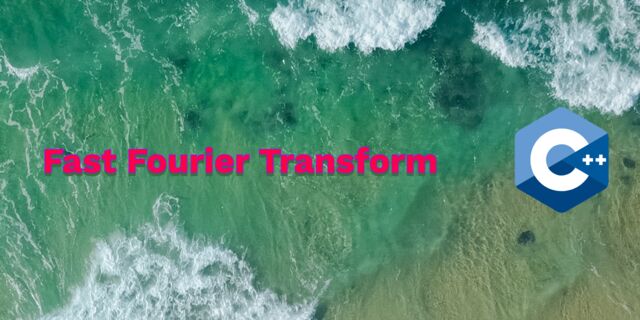 Fast Fourier Transform
Fast Fourier Transform
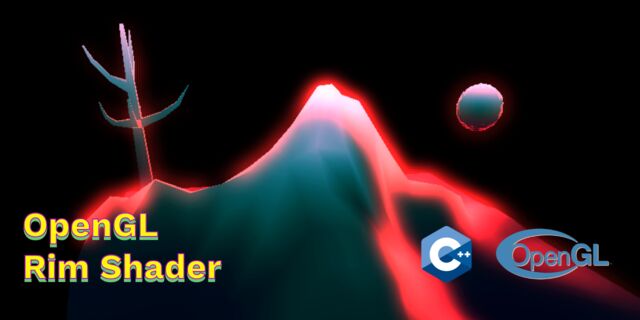 OpenGL Rim Shader
OpenGL Rim Shader
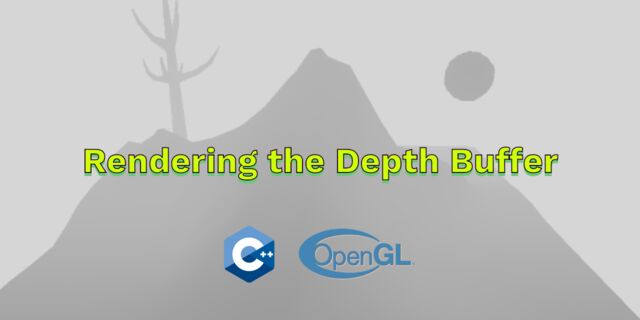 Rendering The Depth Buffer
Rendering The Depth Buffer
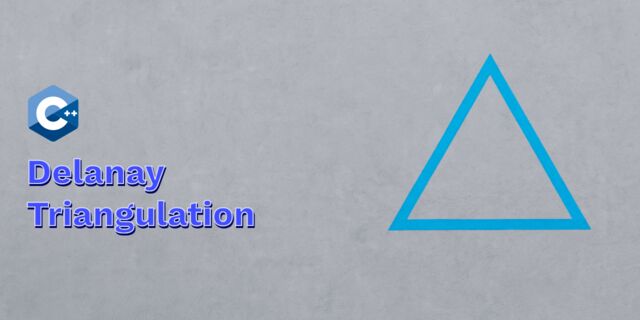 Delaunay Triangulation
Delaunay Triangulation
 RapidXML
RapidXML
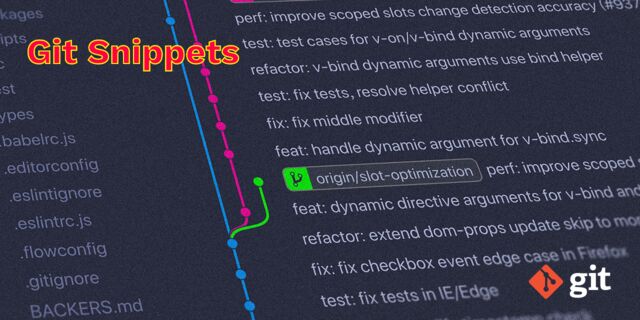 Git Snippets
Git Snippets
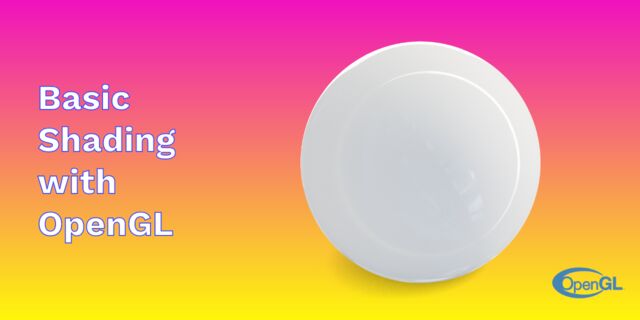 Basic Shading With OpenGL
Basic Shading With OpenGL
 Open Source Libraries For Creative Coding
Open Source Libraries For Creative Coding
 Bouncing particle effect
Bouncing particle effect
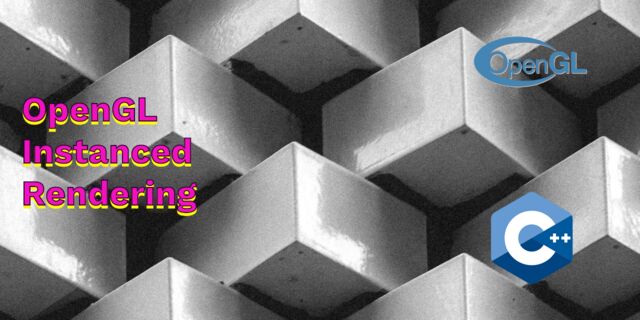 OpenGL Instanced Rendering
OpenGL Instanced Rendering
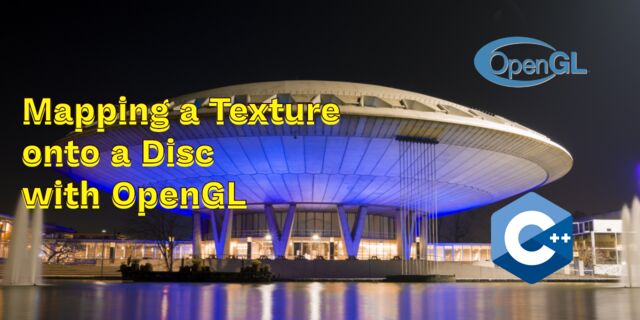 Mapping a texture on a disc
Mapping a texture on a disc
 Download HTML page using CURL
Download HTML page using CURL
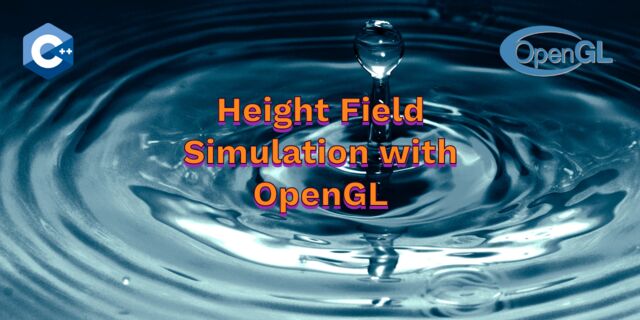 Height Field Simulation on GPU
Height Field Simulation on GPU
 OpenCV
OpenCV
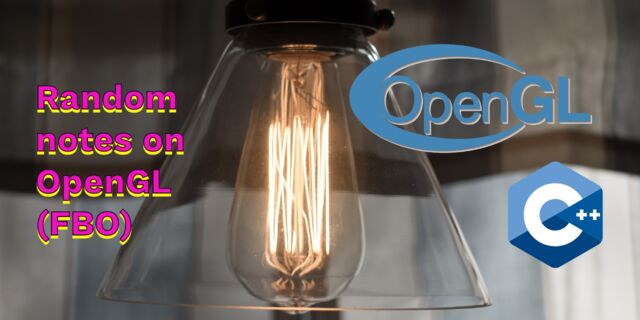 Some notes on OpenGL
Some notes on OpenGL
 Math
Math
 Gists to remember
Gists to remember
 Reverse SSH
Reverse SSH
 Working Set
Working Set
 Consumer + Producer model with libuv
Consumer + Producer model with libuv
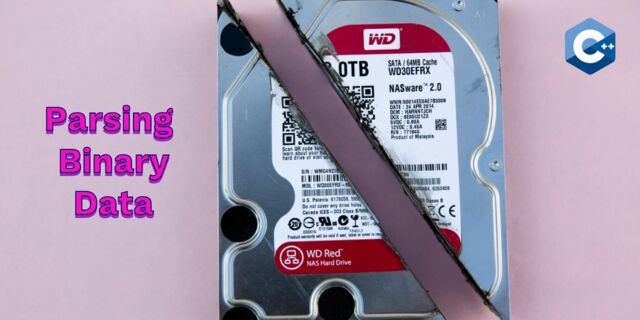 Parsing binary data
Parsing binary data
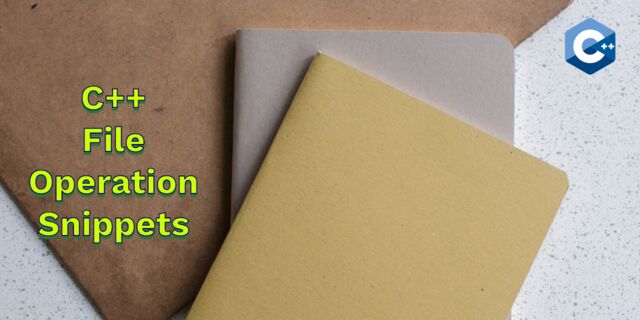 C++ file operation snippets
C++ file operation snippets
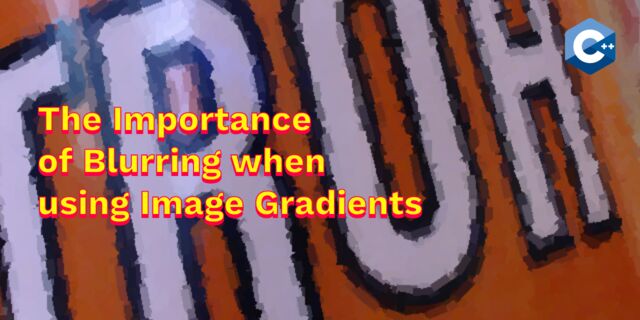 Importance of blur with image gradients
Importance of blur with image gradients
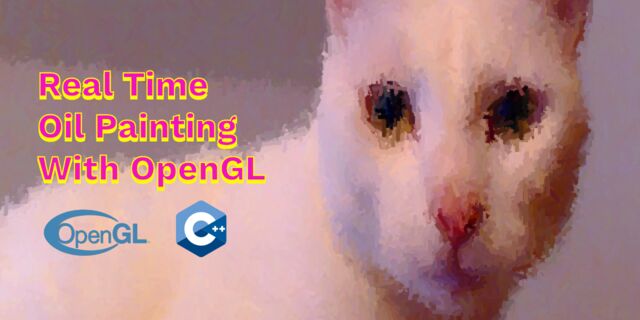 Real-time oil painting with openGL
Real-time oil painting with openGL
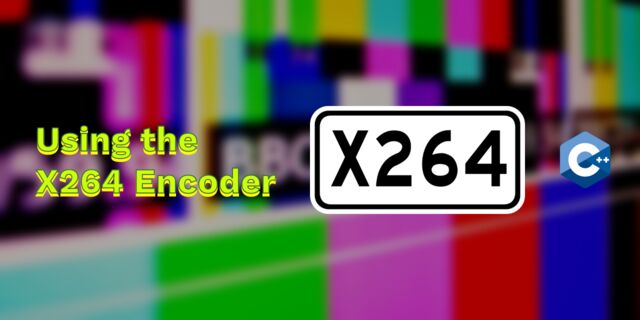 x264 encoder
x264 encoder
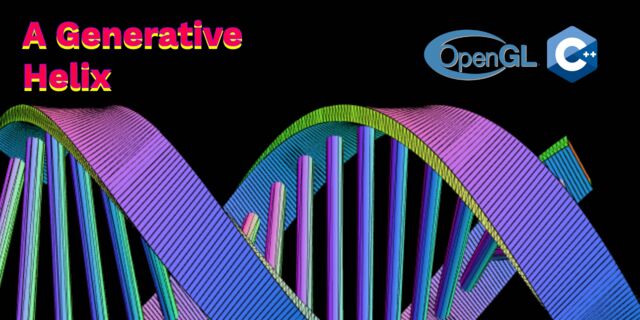 Generative helix with openGL
Generative helix with openGL
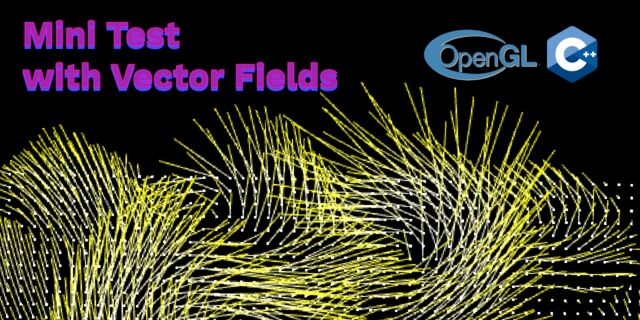 Mini test with vector field
Mini test with vector field
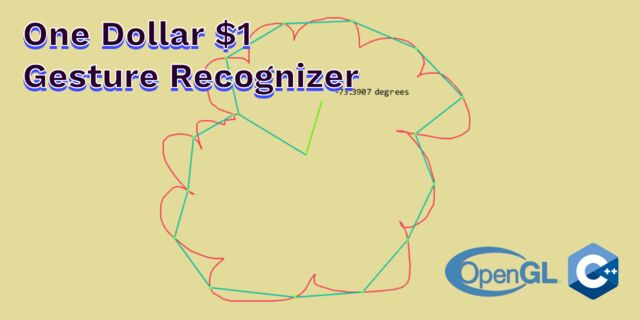 Protractor gesture recognizer
Protractor gesture recognizer
 Hair simulation
Hair simulation
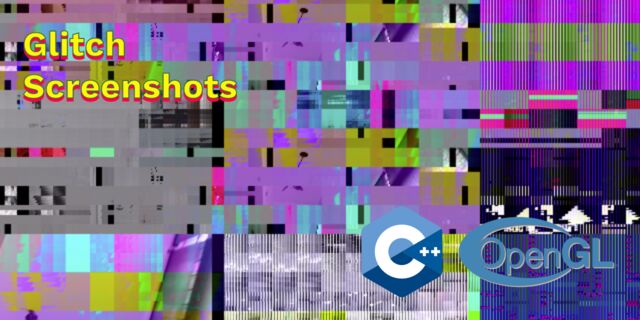 Some glitch screenshots
Some glitch screenshots
 Working on video installation
Working on video installation
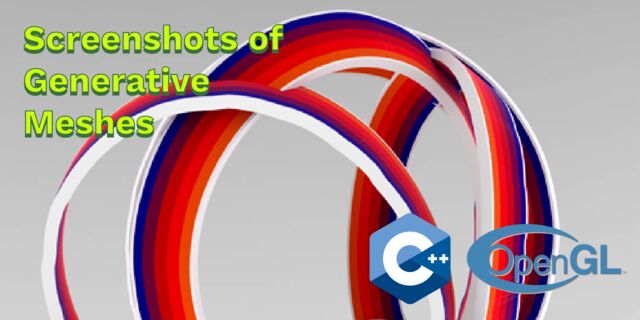 Generative meshes
Generative meshes
 Converting video/audio using avconv
Converting video/audio using avconv
 Auto start terminal app on mac
Auto start terminal app on mac
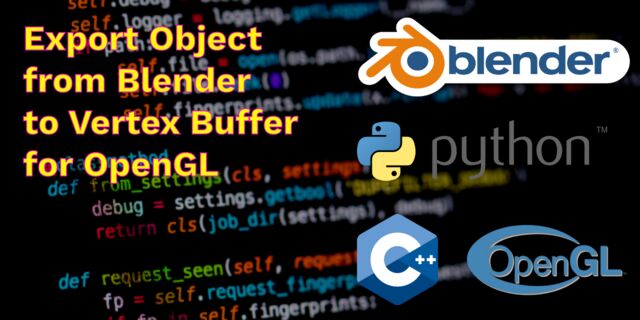 Export blender object to simple file format
Export blender object to simple file format